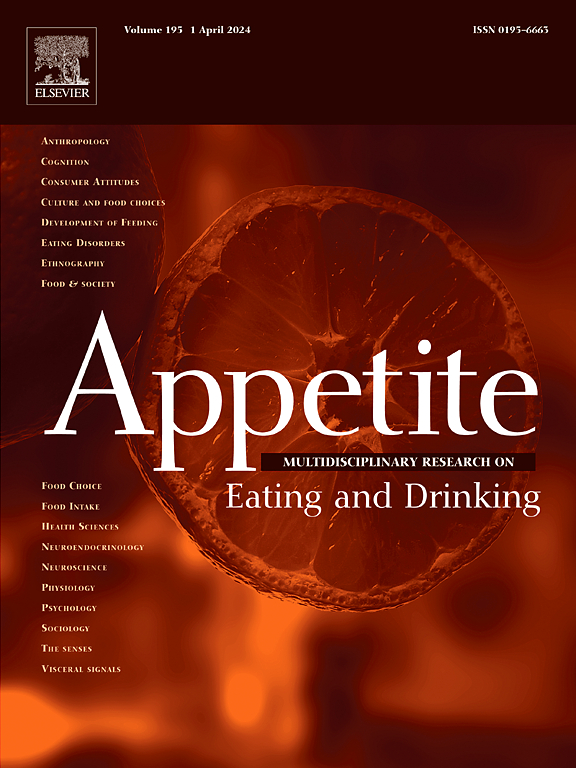综合情绪进食量表(CEES)的编制与初步验证。
IF 4.6
2区 医学
Q1 BEHAVIORAL SCIENCES
引用次数: 0
摘要
在情绪性进食(EE)中,情感状态影响进食欲望和/或进食行为。大多数关于情感表达的研究都集中在对负面情绪的反应中,前者与体重增加和暴饮暴食症(ED)症状有关,而后者与体重低和限制性型ED有关。支持两种形式的负性情感表达的个体比报告单向负性情感表达的个体更受损。人们对积极情绪对饮食的影响知之甚少,部分原因是缺乏将积极的饮食过量和饮食不足作为单独的概念进行自我报告。综合情绪进食量表(CEES)是一种衡量积极和消极饮食过量和饮食不足的四因素量表,本研究主要包括项目减少和初始因子效度(主要目标)和收敛效度(次要目标)。CEES最初的134个条目库是基于对现有情绪进食量表和积极和消极影响量表中的情绪词汇的回顾。减少了项目池,并使用探索性图形分析确定了四个因素。采用验证性因子分析对最终40项的结构进行评价。使用以身体形象为中心的饮食失调和ARFID症状的测量方法建立了阴性饮食过量和饮食不足量表的收敛效度,并报告了阳性饮食过量和饮食不足相关的探索性数据。CEES在美国便利样本中显示了因子效度和收敛效度的初步证据。它允许对情绪化进食的所有四个象限进行分类。本文章由计算机程序翻译,如有差异,请以英文原文为准。
Development and preliminary validation of the comprehensive emotional eating scale (CEES)
In emotional eating (EE), affective states influence desire to eat and/or eating behavior. Most research on EE focuses on over-/under-eating in response to negative emotions, the former of which is related to higher weight and binge-spectrum eating disorder (ED) symptoms while the latter has been implicated in low weight and restrictive-only ED. Individuals endorsing both forms of negative EE are more impaired than those reporting unidirectional negative EE. Less is known about the influence of positive emotions on eating, in part due to a lack of self-report measures of positive over- and under-eating as separate constructs. The current study presents the development, including item reduction and initial factorial validity (primary aims) and convergent validity (secondary aims) of the Comprehensive Emotional Eating Scale (CEES), a four-factor measure of positive and negative over- and under-eating. The initial 134-item pool for the CEES was based on a review of extant emotional eating scales and emotion words from the Positive and Negative Affect Schedule. The item pool was reduced and four factors identified using exploratory graphical analysis. The structure of the final set of 40 items was evaluated using confirmatory factor analysis. Convergent validity of the negative over- and under-eating scales was established using measures of body image-focused eating disorder and ARFID symptoms, and exploratory data on the correlates of positive over- and under eating were reported. The CEES showed preliminary evidence of factorial and convergent validity in a US-based convenience sample. It allows for classification on all four quadrants of emotional eating.
求助全文
通过发布文献求助,成功后即可免费获取论文全文。
去求助
来源期刊

Appetite
医学-行为科学
CiteScore
9.10
自引率
11.10%
发文量
566
审稿时长
13.4 weeks
期刊介绍:
Appetite is an international research journal specializing in cultural, social, psychological, sensory and physiological influences on the selection and intake of foods and drinks. It covers normal and disordered eating and drinking and welcomes studies of both human and non-human animal behaviour toward food. Appetite publishes research reports, reviews and commentaries. Thematic special issues appear regularly. From time to time the journal carries abstracts from professional meetings. Submissions to Appetite are expected to be based primarily on observations directly related to the selection and intake of foods and drinks; papers that are primarily focused on topics such as nutrition or obesity will not be considered unless they specifically make a novel scientific contribution to the understanding of appetite in line with the journal's aims and scope.
 求助内容:
求助内容: 应助结果提醒方式:
应助结果提醒方式:


